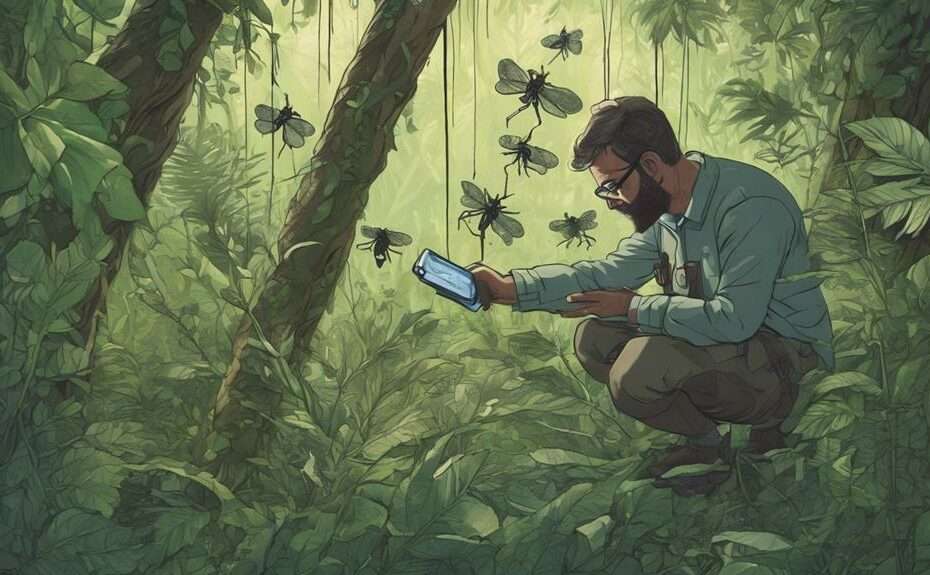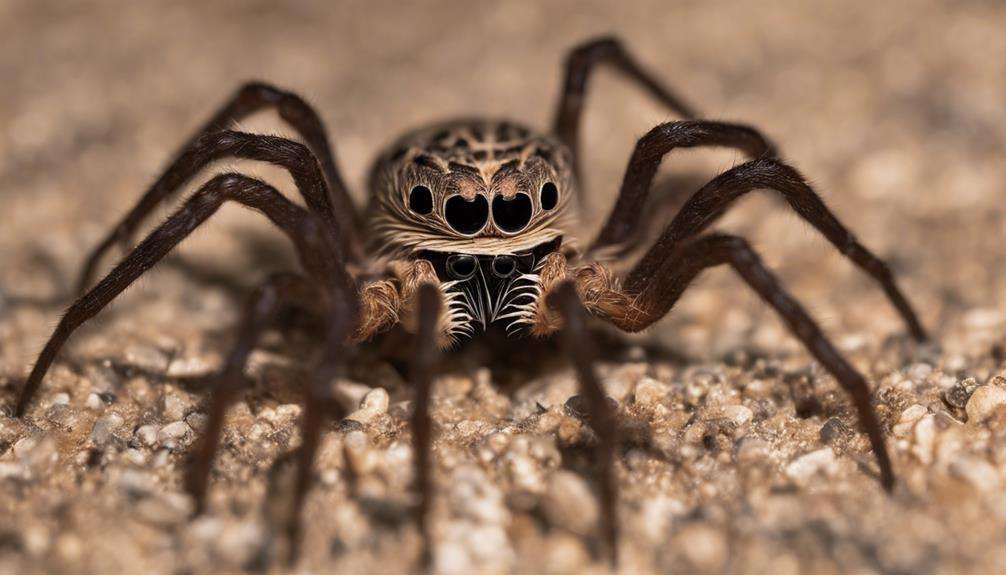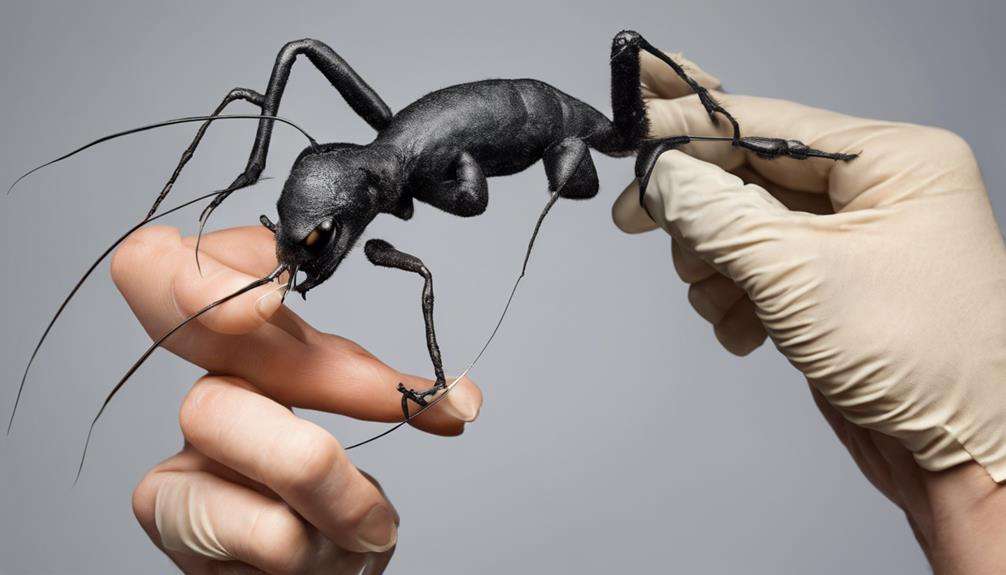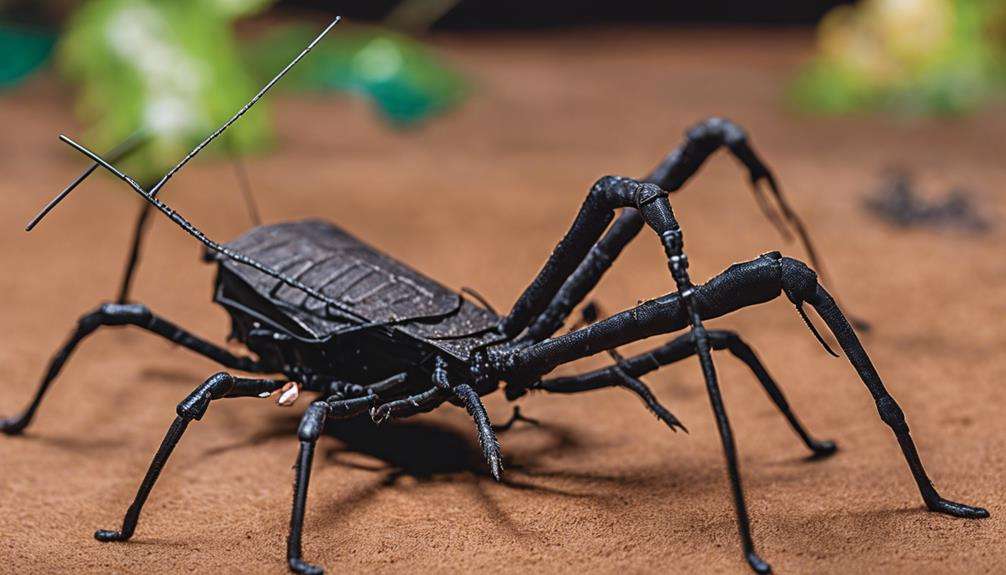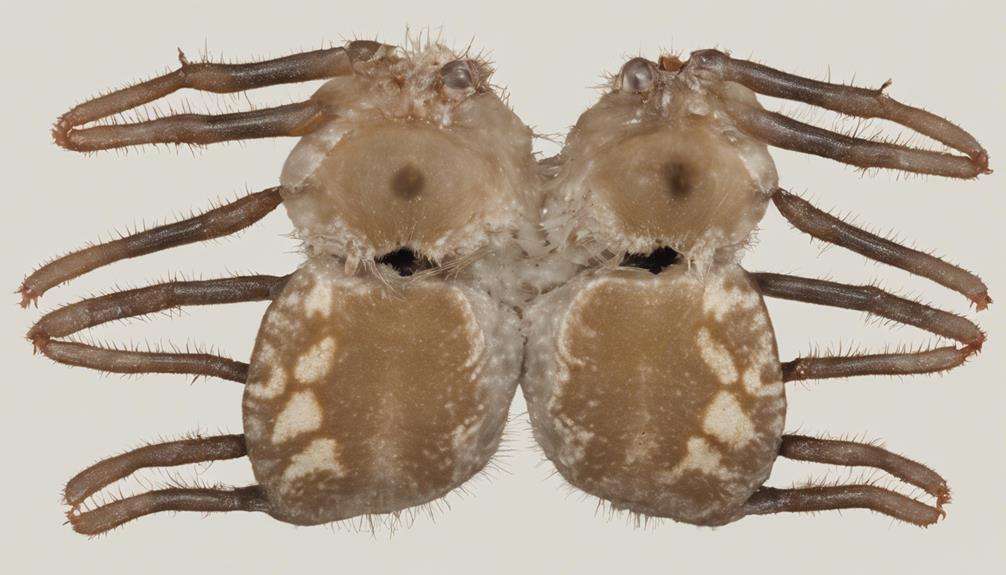Imagine stumbling upon a hidden treasure trove, shrouded in mystery and waiting to reveal its ancient secrets.
Similarly, the exploration of uncommon pet Amblypygid species unveils a world of enigmatic creatures with tales as intriguing as their unique physical features.
As you begin to unravel the mysteries surrounding these lesser-known arachnids, you'll uncover a web of interconnected stories that challenge conventional wisdom and spark curiosity about the origins of these fascinating creatures.
Key Takeaways
- Fossil discoveries unveil ancient Amblypygid ancestors and evolutionary timeline.
- Early Amblypygid morphology shows gradual adaptations for survival and diversification.
- Specialized sensory structures and hunting strategies evolved over time.
- Insights into Amblypygid species traits, adaptations, ecology, and reproduction.
Ancient Amblypygid Fossil Discoveries
During the exploration of ancient geological layers, remarkable discoveries of amblypygid fossils have shed light on the evolution of these intriguing arachnids. Amblypygids, belonging to the order Amblypygi, have left traces dating back to the Devonian period, with more complete fossils emerging from the Carboniferous era onwards.
These fossils, found in various forms like slabs, nodules, and amber, offer valuable insights into the morphology and evolutionary history of these creatures. Through morphological analyses of both fossil and modern amblypygids, researchers have observed changes in shield breadth and appendage elongation over time, providing significant clues about the evolutionary trajectory of these arachnids.
Scientists have delved into the phylogeny of fossil amblypygids, meticulously studying numerous specimens to unravel the intricate evolutionary framework of this arachnid order. Specific fossil specimens such as Sorellophrynus carbonarius, Thelyphrynus elongatus, and Weygoldtina anglica have been meticulously examined, further enriching our understanding of ancient amblypygid species.
Amblypygid Evolutionary Timeline
In exploring the Amblypygid evolutionary timeline, you'll examine the emergence of early Amblypygid ancestors during the Devonian period, marking the beginnings of their lineage.
The diversification of Amblypygids over millions of years will be traced through fossil specimens from the Carboniferous period onwards, showcasing the evolutionary journey of these unique arachnids.
Analyses of morphological changes in shield breadth and appendage elongation will unveil key evolutionary adaptations that have shaped the development of Amblypygids over time.
Early Amblypygid Ancestors
Early in the evolutionary history of amblypygids, primitive whip spiders from the Carboniferous period provide crucial insights into the gradual development of these fascinating arachnids.
- Fossil records reveal ancient amblypygid ancestors dating back to the Carboniferous period.
- The morphology of early amblypygids shows gradual adaptations for predation and survival.
- Specialized sensory structures and hunting strategies evolved in ancestral forms over time.
- Amblypygid fossils highlight the lineage and morphological changes leading to the diverse species seen today.
Diversification of Amblypygids
Pivoting from the exploration of early amblypygid ancestors, the gradual morphological adaptations observed in fossil specimens provide significant insights into the diversification of amblypygids over millions of years.
Fossil whip spiders, such as Weygoldtina anglica from the Carboniferous era, play a crucial role in understanding the evolutionary trajectory of amblypygids. These ancient arachnids exhibit morphological features that hint at the environmental pressures they faced and how they adapted over time.
Key Evolutionary Adaptations
Exploring the evolutionary timeline of amblypygids reveals a fascinating journey marked by key adaptations that shaped their survival strategies and specialized hunting behaviors.
- Ancient Origins: Amblypygids date back to the Devonian period, with fossil evidence showcasing their ancient roots.
- Unique Sensory Organs: Key adaptations include the development of specialized sensory organs for hunting and navigation.
- Diversification: Amblypygids diversified over time, adapting to varied environments and giving rise to distinct species with specialized traits.
- Morphological Changes: Fossil records provide valuable insights into the evolutionary history of amblypygids, illustrating significant changes in morphology and adaptations over millions of years.
Studying the evolutionary timeline of amblypygids offers crucial insights into the factors influencing their diversification and survival across different ecosystems.
Unusual Habits of Amblypygid Species
Among the intriguing behaviors observed in certain amblypygid species is the creation of air bubbles to facilitate underwater breathing. This unique adaptation allows them to survive in aquatic environments for extended periods. These arachnids, known for their whip-like front limbs used for sensing and capturing prey, demonstrate remarkable resourcefulness in their quest for survival.
Additionally, some amblypygid species exhibit parthenogenesis, a form of asexual reproduction, enabling them to reproduce without mating. In captivity, these creatures display interesting feeding habits, such as their methodical approach to locating and consuming prey, showcasing their predatory prowess. Furthermore, amblypygid species engage in specific grooming behaviors, meticulously cleaning their sensory organs and legs to maintain optimal functionality.
Social interactions within captive amblypygid communities reveal intricate communication patterns and hierarchy establishment. Studying these unusual habits provides valuable insights into the natural behaviors and adaptations of these fascinating creatures, shedding light on their unique evolutionary strategies.
Amblypygid Species Distribution Patterns
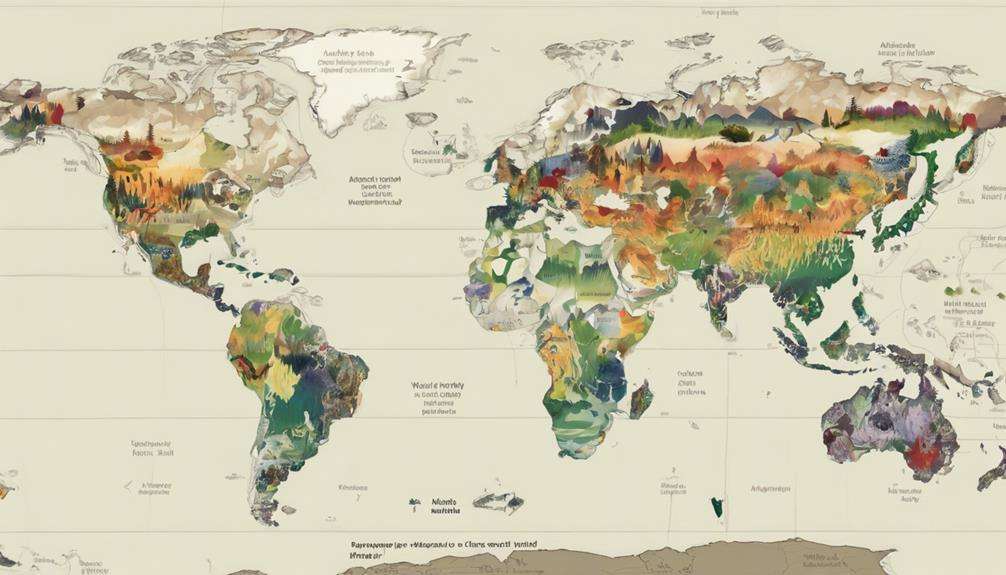
Amblypygid species demonstrate a wide geographical range, with their presence documented across diverse continents such as Europe and South America. Investigating their habitat preferences provides insights into the environmental factors shaping their distribution patterns.
Understanding the influences on their dispersal can illuminate how amblypygids navigate various landscapes and adapt to human-altered environments.
Geographic Distribution Overview
With a wide geographic distribution spanning from Europe to South America, Amblypygid species exhibit diverse distribution patterns that raise questions about human-mediated dispersal and potential impacts on their habitats. Amblypygi's distribution is a complex puzzle with intriguing aspects:
- Populations found in unexpected urban areas challenge traditional habitat assumptions.
- Conservation strategies must consider the global connectivity impacting Amblypygi habitats.
- The mystery surrounding certain populations, like the Trieste group, sparks theories of unique dispersal methods.
- Ongoing discoveries emphasize the need for continual monitoring to understand the full extent of Amblypygid biodiversity.
Habitat Preferences Analysis
Exploring the habitat preferences of Amblypygid species reveals a fascinating array of diverse environments they inhabit, ranging from tropical rainforests to urban settings. These arachnids show a remarkable adaptability, with certain species gravitating towards specific microhabitats such as caves, tree bark, or leaf litter for shelter and hunting purposes.
Interestingly, urban areas have also become home to amblypygids, showcasing their ability to thrive in human-altered environments like gardens, buildings, and parks. The distribution patterns of Amblypygid species exhibit localized populations in various regions, suggesting habitat specialization and potential isolation.
Understanding these intricate habitat preferences is essential for effective conservation strategies and for managing human interactions to safeguard these unique creatures.
Factors Influencing Distribution
Factors influencing the distribution patterns of Amblypygid species include habitat availability, climate suitability, and prey abundance. Understanding these factors is crucial for comprehending the range of these unique arachnids. Here are some key points to consider:
- Habitat availability: Different species of Amblypygids have specific habitat requirements, influencing where they can be found.
- Climate suitability: Amblypygid species are often limited to regions with suitable temperature and humidity levels for their survival.
- Prey abundance: The availability of suitable prey impacts the distribution patterns of Amblypygids, as they rely on specific food sources.
- Human-mediated dispersal: Human activities can unintentionally introduce Amblypygid species to new areas, affecting their distribution patterns.
Amblypygid Species Genetic Adaptations

Genetic adaptations in amblypygid species significantly contribute to their ability to thrive in a wide range of environments, underscoring their remarkable evolutionary resilience. Amblypygids, also known as whip spiders or tailless whip scorpions, have evolved unique genetic variations that play crucial roles in their survival. Studies have identified genetic traits linked to sensory perception, aiding them in detecting prey and navigating their surroundings effectively. These adaptations are particularly noteworthy in amblypygid populations inhabiting diverse habitats, showcasing their ability to adapt to different environmental challenges.
Furthermore, genetic research has unveiled specialized prey capture mechanisms in amblypygid species, enhancing their success as ambush predators. Variations in their genetic makeup have led to the development of efficient hunting strategies, allowing them to secure prey with precision. Additionally, genetic adaptations have equipped amblypygids with chemosensory abilities and adaptive behaviors essential for their survival in various ecosystems. Understanding these genetic adaptations offers valuable insights into the evolutionary history and ecological success of amblypygid species.
Amblypygid Species Unique Morphology
With their unique morphology serving as a testament to their evolutionary adaptations, amblypygid species exhibit specialized anatomical features essential for their survival and predatory prowess. These spiders, known as Amblypygi, have evolved distinct characteristics that set them apart from other arachnids:
- Elongated Pedipalps: Amblypygids possess elongated pedipalps that serve both sensory functions and aid in capturing prey efficiently.
- Flattened Bodies and Leg-like Appendages: Their flattened bodies and leg-like appendages contribute to their cryptic appearance, allowing them to blend seamlessly into their environment while enhancing their predatory lifestyle.
- Heart-shaped Dorsal Shield: Amblypygids sport a unique heart-shaped dorsal shield that not only protects vital organs but also assists in camouflaging them from potential predators.
- Segmented Bodies: The segmentation of their bodies provides amblypygids with the flexibility and agility needed to navigate various terrains with ease, enhancing their hunting and survival capabilities.
These morphological features collectively highlight the specialized adaptations that have allowed Amblypygi to thrive in their ecological niche.
Amblypygid Species Ecological Niche

Amblypygid species play integral ecological roles as nocturnal predators, feeding on a variety of prey such as insects, spiders, and small vertebrates.
Their habitat preferences span from tropical forests to urban settings, showcasing their adaptability to diverse environments.
Amblypygids thrive in humid conditions, utilizing their cryptic behavior and unique morphology to blend into their surroundings and effectively hunt for prey.
Ecological Roles of Amblypygids
Playing a crucial role in nocturnal ecosystems, amblypygids serve as efficient predators, maintaining natural balance by preying on insects, spiders, and other small invertebrates in their habitat.
- Efficient Predators: Amblypygids are adept at capturing prey due to their cryptic nature and ambush hunting strategy.
- Population Control: These arachnids contribute significantly to controlling insect populations, which helps in regulating ecosystem dynamics.
- Beneficial Pest Control: Amblypygids are often considered beneficial organisms for humans due to their role in pest control.
- Biodiversity Maintenance: Studying amblypygids' ecological niche aids in understanding their role in maintaining biodiversity within their ecosystems.
Amblypygids play a vital role in the intricate web of nocturnal ecosystems, showcasing their importance in the delicate balance of nature.
Habitat Preferences of Amblypygids
In their natural habitats, amblypygids exhibit a preference for dark, sheltered environments like caves, tree hollows, and leaf litter to closely mimic their ecological niche.
The leaf litter provides a crucial microhabitat for these arachnids, offering protection from predators and serving as a hunting ground for small arthropods. Within the leaf litter layer, amblypygids can effectively camouflage themselves, blending seamlessly with the surroundings to remain undetected.
This habitat choice aligns with their cryptic lifestyle, allowing them to ambush prey while avoiding detection by potential threats. The leaf litter also contributes to maintaining the necessary humidity levels for amblypygids, essential for their nocturnal activities and overall survival in these specialized ecosystems.
Amblypygid Species Reproductive Strategies
Utilizing a range of reproductive strategies, pet amblypygid species demonstrate a fascinating complexity in their approaches to ensuring population survival and genetic diversity. Among these strategies, parthenogenesis stands out as a remarkable phenomenon observed in amblypygids.
- Parthenogenesis: Females can reproduce without mating with males, leading to genetically identical colonies established by a single female.
- Environmental Influence: Factors like environmental conditions play a crucial role in the prevalence of parthenogenesis in amblypygids, offering both risks and advantages for population survival.
- Unique Biology: The reproductive behavior of amblypygid species, including parthenogenesis, contributes significantly to their distinctive biology and evolutionary adaptations.
- Population Dynamics: Understanding these reproductive strategies, particularly parthenogenesis, is vital for unraveling the population dynamics and genetic diversity of amblypygid species.
The exploration of these reproductive strategies sheds light on the intricate mechanisms employed by pet amblypygid species to perpetuate their populations and ensure genetic variability in their communities.
Amblypygid Species Behavioral Studies

Amblypygid species exhibit intricate behavioral patterns, showcasing unique hunting techniques and complex social interactions that provide insights into their adaptive capabilities and evolutionary strategies.
Behavioral studies on amblypygid species have revealed fascinating hunting strategies, such as using their elongated front legs to sense prey vibrations. These studies also highlight the complex social behaviors displayed by amblypygids, including territorial displays and communication through vibrations.
Researchers have documented maternal care behaviors in certain amblypygid species, where females carry their eggs and young on their abdomen for protection. Additionally, observations have shown amblypygids displaying adaptive behaviors in response to environmental stimuli, demonstrating their ability to navigate and thrive in diverse habitats.
Furthermore, behavioral research has shed light on the intricate mating rituals of amblypygid species, characterized by courtship displays and mate recognition through pheromones. These studies provide valuable insights into the behavioral repertoire of amblypygids, showcasing their remarkable abilities and complex social dynamics.
Amblypygid Species Conservation Concerns
Amidst the challenges posed by habitat loss, climate change, and human activities, the conservation of amblypygid species has become a critical concern requiring urgent attention.
- Deforestation and urbanization threaten the natural habitats of amblypygids, leading to declines in their populations.
- Amblypygids' specialized habitat requirements make them vulnerable to environmental changes and disturbance, necessitating conservation efforts.
- Limited knowledge about the ecology and distribution of amblypygid species hinders effective conservation planning and management strategies.
- Conservation initiatives focusing on preserving the habitats and biodiversity of amblypygids are essential to prevent their extinction and promote species survival.
Conservation initiatives play a crucial role in safeguarding amblypygid species from the threats they face. Efforts directed at protecting their habitats, understanding their ecological needs, and implementing management strategies are vital in ensuring the long-term survival of these unique arachnids. By addressing the challenges of habitat loss, climate change, and human impact through targeted conservation actions, we can work towards securing a sustainable future for amblypygid species.
Frequently Asked Questions
Are Whip Spiders Actually Spiders?
Whip spiders, or amblypygids, are not actual spiders. Their evolutionary relationships diverge due to unique features like elongated front legs for sensing. Amblypygids lack spinnerets and silk glands, setting them apart morphologically from true spiders.
What Is the Origin of the Word Amblypygi?
You ponder the origin of the word 'Amblypygi.' Etymology analysis reveals its Greek roots, 'amblys' for blunt and 'pyge' for buttocks. The term captures the unique flat-bodied arachnids, coined by Carl Thorell in 1883.
Are Tailless Whip Scorpions Spiders or Scorpions?
Tailless whip scorpions, or amblypygids, are not spiders but belong to a distinct group. Their unique features like lack of silk glands and venom, along with raptorial pedipalps, contribute to their evolutionary classification separate from spiders or scorpions.
Do Whip Spiders Bite?
Whip spiders, known as amblypygids, rarely bite. Their behavior patterns show reliance on defense mechanisms like spines on legs rather than biting. These creatures, though intimidating in appearance, are docile and use retreat as a primary defense.
Conclusion
As you reflect on the intricate world of uncommon pet Amblypygid species, you're reminded of the delicate balance of nature and the interconnectedness of all living organisms.
Just as these fascinating arachnids adapt to diverse environments, so too must we adapt our conservation efforts to protect their unique habitats.
By delving deeper into the behavior, genetics, and evolution of Amblypygids, we unravel a tapestry of life that continues to astonish and inspire.
